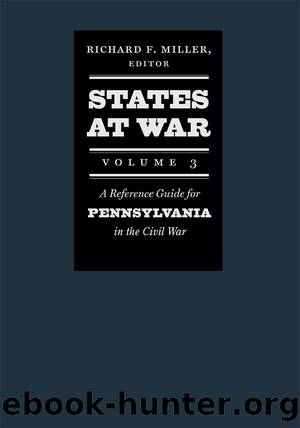States at War, Volume 3 by Richard F. Miller

Author:Richard F. Miller [Miller, Richard F.]
Language: eng
Format: epub
Tags: Nonfiction, Reference & Language, Reference, Bibliographies, History, Americas, United States, Civil War Period (1850-1877)
ISBN: 9781611686203
Publisher: University Press of New England
Published: 2014-11-04T05:00:00+00:00
1865
Key Events
JANUARY
2:Fryâs Circular No. 1 declares that quotas under the call of December 19, 1864, âmust not be reduced except by actual enlistments in the Army, Navy, and Marine Corps.â This causes great anxiety among the states.1 (See entry for January 10.)
3:The legislature convenes.
10:Circular No. 1, issued January 2, is understood by the states to mean that the War Department will not allow them to offset quotas by prior surpluses. Thus, the department is seen to renege on its earlier agreements. Governor James T. Lewis of Wisconsin complains about this to Stanton.2
12:Fry answers Minnesota governor Stephen Millerâs concerns about whether Circular No. 1 disallows surpluses. After a lengthy explanation of how the new formula works, Fry confirms that surpluses will be allowed.3
13:Thomas A. Scott, the former assistant secretary of war, has returned to his post as vice president of the Pennsylvania Railroad Company. He restates for Fry his understanding about exemptions, then makes a proposal. âIn order to retain skilled employes of our several lines of railway, which is essential to the best interest of the Government, we desire to make an arrangement with you by which we can put into the Army and Navy good, acceptable substitutes for three years in place of those of our men who may be drafted under the calls of the Government.â The railroad would deliver substitutes at Philadelphia, Pittsburgh, or Harrisburg; once accepted, the United States would agree to issue certificates to those men credited with furnishing the substitutes, âno matter in what district they may have been enrolled or drafted.â Scott adds that while the draft is for one yearâs service, his substitutes will be for three years. âQuite a good trade for you in that respect,â he tells Fry, âand as far as we are concerned we will be enabled to keep our railroad facilities in good shape for the uses of the Government and the public generally.â Stanton approves.4
18:Russell joins the adjutant generals of Iowa, Massachusetts, Vermont, Kentucky, Wisconsin, Rhode Island, Ohio, Connecticut, and New Hampshire in a letter to Stanton asking, among other things, that recruiting be returned to state governors, and (perhaps more realistically) that the reversal of credit against quota that occurs in cases of desertion and bounty jumping not be debited against states, but against the quota of the town (âsub-districtâ) that sent these unfaithful draftees. The hope is that âgreater care would be thereby insured on the part of principals in procuring reliable men as substitutes.â
Separately, George H. Boker,5 secretary of the Philadelphia Union League, requests authority from ASW Charles A. Dana for a new one-year regiment, commanded by veteran officers, all of whom will be commissioned by Curtin.6
22:Fry grants Bokerâs January 18 request for another regiment. âPlease proceed at once,â he instructs, then changes the conversation to Representative Recruits. (See entry for June 26, 1864.) âAre there not a thousand men in Philadelphia who are willing each to put in a representative recruit in accordance with Circular 25 of June last . . .
Download
This site does not store any files on its server. We only index and link to content provided by other sites. Please contact the content providers to delete copyright contents if any and email us, we'll remove relevant links or contents immediately.
Asking the Right Questions: A Guide to Critical Thinking by M. Neil Browne & Stuart M. Keeley(5572)
Autoboyography by Christina Lauren(5154)
Eat That Frog! by Brian Tracy(4378)
Dialogue by Robert McKee(4271)
Sticky Fingers by Joe Hagan(4060)
Journeys Out of the Body by Robert Monroe(3537)
Annapurna by Maurice Herzog(3395)
Full Circle by Michael Palin(3346)
Schaum's Quick Guide to Writing Great Short Stories by Margaret Lucke(3278)
Elements of Style 2017 by Richard De A'Morelli(3278)
The Art of Dramatic Writing: Its Basis in the Creative Interpretation of Human Motives by Egri Lajos(2944)
Why I Write by George Orwell(2849)
The Diviners by Libba Bray(2840)
In Patagonia by Bruce Chatwin(2829)
The Mental Game of Writing: How to Overcome Obstacles, Stay Creative and Productive, and Free Your Mind for Success by James Scott Bell(2816)
The Fight by Norman Mailer(2794)
Atlas Obscura by Joshua Foer(2758)
Venice by Jan Morris(2495)
The Elements of Style by William Strunk and E. B. White(2413)
